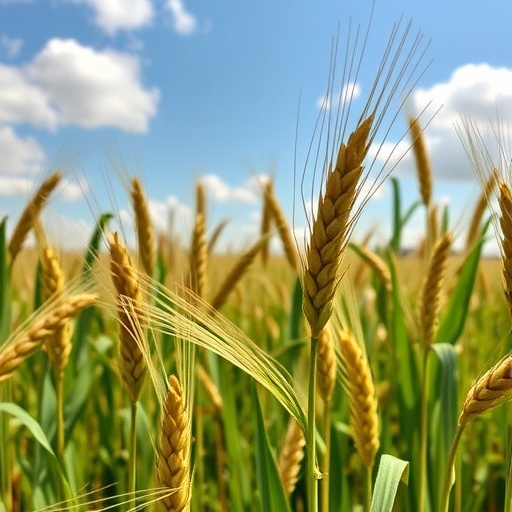Nitrogen fertilizers have long been a cornerstone of intensified agriculture, dramatically increasing crop yields to meet the demands of a growing global population. Yet, this agricultural boon comes with a high environmental cost. Over half of the nitrogen applied to croplands is lost to the atmosphere or leaches into waterways, causing severe pollution, greenhouse gas emissions, soil acidification, and a disruption of global nitrogen cycles. Climate change, ecosystem degradation, and biodiversity loss are some of the cascading consequences of excessive nitrogen fertilizer use, underscoring the urgent need for sustainable agricultural practices.
In an innovative departure from traditional breeding methods focused solely on plant genetics, researchers led by Wolfram Weckwerth at the University of Vienna are pioneering a new approach rooted in the holobiont concept. This paradigm recognizes the intimate, co-evolutionary relationships between plants and their associated microbiomes—the communities of microbes inhabiting the root and leaf environments. By targeting this intricate plant-microbe symbiosis, breeders can harness natural biological mechanisms to reduce dependence on synthetic nitrogen fertilizers and enhance crop resilience against climate pressures.
Central to this approach is the exploitation of biological nitrification inhibitors (BNIs), naturally occurring compounds exuded by certain plant roots that suppress the microbial processes converting soil ammonium to nitrate. Since nitrate tends to be more mobile and prone to leaching, BNIs effectively slow nitrogen loss and improve nitrogen use efficiency. Although BNIs have been identified in a few species, understanding their variation within major crops like wheat has remained elusive due to the complexity of microbial interactions and biochemical pathways.
.adsslot_0a7DSiX2Ke{ width:728px !important; height:90px !important; }
@media (max-width:1199px) { .adsslot_0a7DSiX2Ke{ width:468px !important; height:60px !important; } }
@media (max-width:767px) { .adsslot_0a7DSiX2Ke{ width:320px !important; height:50px !important; } }
ADVERTISEMENT
To address this, the research team conducted a detailed examination of root exudates from a diverse set of elite wheat cultivars, discovering significant variation in BNI activity across genotypes. This natural variability represents a powerful genetic resource. By profiling these root secretions using advanced metabolomic techniques and integrating microbiome sequencing data, scientists can now identify high-BNI lines capable of fostering beneficial soil microbiomes that promote nitrogen retention and soil health.
Arindam Ghatak, the first author of the study, emphasizes the sophistication required in characterizing root exudates, which encompass a complex mixture of metabolites that modulate microbial community structures in the rhizosphere. Such chemical dialogues select for microbial strains adept at inhibiting nitrification, thereby stabilizing nitrogen in forms more accessible to plants. Cultivating wheat varieties expressing robust BNI activity thus emerges as a promising strategy to reduce fertilizer inputs without sacrificing yield.
To scale this concept beyond the laboratory, the team developed a novel data-driven breeding framework that integrates plant genomics, soil microbiome profiling, and PANOMICS datasets—including transcriptomics, metabolomics, and proteomics. This systems biology approach, deployed through machine learning algorithms, can unravel multifaceted interactions within the plant holobiont and predict plant genotypes with optimal microbiome assembly and nitrogen use traits. The international collaboration spanned continents—from Europe to Asia and the Americas—reflecting the global imperative of sustainable agriculture.
Moreover, crops developed under this framework are expected to exhibit greater resilience to abiotic stresses such as drought and extreme temperatures, conditions increasingly exacerbated by climate change. Improving root exudate profiles to shape beneficial microbiomes could also reduce the need for chemical pesticides by promoting pathogen-suppressive soil communities. This integrative strategy paves the way toward truly sustainable farming systems that harmonize productivity with ecological stewardship.
While the promise is substantial, challenges remain in translating these findings into field-scale practices. The complexity and context-dependence of soil microbiomes necessitate extensive validation across diverse environments to ensure stable BNI expression and beneficial microbiome assembly. Additionally, breeding for microbiome traits requires new phenotyping methods and robust computational tools to manage vast datasets. Nonetheless, the early successes demonstrated by Weckwerth’s team provide a beacon for the future of agro-biotechnology.
In parallel with experimental breeding, advances in synthetic biology and microbiome engineering offer complementary routes to harness plant holobionts. The integration of bioinformatics, remote sensing, and precision agriculture technologies will further enable targeted management of plant-microbe interactions in situ. Together, these innovations are set to revolutionize how agriculture addresses its environmental footprint, feeding a burgeoning population while safeguarding planetary health.
This research ultimately aligns with the goals of the United Nations Sustainable Development Goals, particularly those related to zero hunger, climate action, and life on land. By fostering crops that optimize natural nitrogen cycling, reduce greenhouse gas emissions, and enhance soil ecosystem services, the holobiont breeding concept stands at the forefront of sustainable agroecosystem design. Continued interdisciplinary efforts will be crucial to realize this vision on a global scale.
As nitrogen management increasingly emerges as a linchpin of agricultural sustainability, integrating biological insights into crop improvement heralds a new era. The convergence of molecular systems biology, ecology, and breeding illustrated by the work of Weckwerth and colleagues inspires transformative pathways to balance human food security with environmental resilience. This holistic perspective may well define the next generation of climate-smart agriculture.
Subject of Research: Nitrogen use efficiency in wheat through plant-microbiome interactions and biological nitrification inhibitors
Article Title: Natural variation of the holobiont for sustainable agroecosystems.
News Publication Date: 27-Jun-2025
Web References: http://dx.doi.org/10.1016/j.tplants.2025.05.006
Image Credits: Weckwerth
Keywords: nitrogen fertilizers, biological nitrification inhibitors, holobiont concept, wheat breeding, soil microbiome, climate change resilience, sustainable agriculture, PANOMICS, machine learning, plant-microbe interactions, nitrogen loss mitigation, agroecosystems
Tags: biodiversity in agriculturebiological nitrification inhibitorsclimate resilience in wheatecosystem degradation solutionsenhancing crop yields sustainablyenvironmental impact of fertilizersholobiont concept in agriculturemachine learning in crop sciencenature-based breeding techniquesnitrogen fertilizer alternativesplant-microbe interactionssustainable agricultural practices





